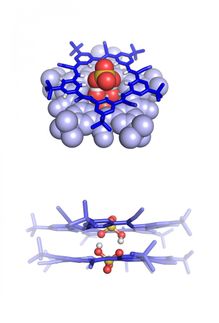Revealing structure and dynamics of glassy polymers during transition
glasses are not, perhaps surprisingly, technically solid in a crystalized form, but are substances frozen in a liquidlike structure. Many fundamental questions remain as to exactly how glasses form, transitioning from flowing liquid to solid glass. A central factor materials scientists study when exploring phenomena about glass, like its formation, is the temperature where this occurs, the glass-transition temperature.
An international collaboration of computational physicists and chemists have shed new light on how the polymer structure bears on this temperature in the forming of glass in atactic polystyrene (PS), a commonly used glass substance.
Alexey Lyulin, a physicist at Technische Universiteit Eindhoven in the Netherlands and visiting faculty member at Stanford University, led the work conducting supercomputer-processed simulations.
"Glass transition is actually a mysterious phenomenon," Lyulin said. "It is still not understood completely, even for very simple liquids."
And polymers, Lyulin adds, are not simple liquids. They have very long chainlike molecules, and generally do not crystalize but form amorphous, glassy solids. This glassy state is important for many applications such as, for example, nanolithography. The polymer interface is also important, as this is where important mechanics and heat transfer between different molecules occur.
Lyulin and his colleagues looked at the polymer glass transition in bulk samples, but were especially interested in thin films of polystyrene. At the nanolevel, these films are often comparable to having one molecule-thickness. In studying the glass transition for polymers at this scale, Lyulin pointed out that researchers want to learn about the relevant dynamics as well as the structure.
"In our paper, we studied only polystyrene structure and what happens to this structure at glass transition when you go to very thin, nanometer-thick films," Lyulin said.
He noted that the paper's authors were familiar with experimental research that indicated in a thin, free-standing film without a substrate, the polystyrene transition temperature is very low, as compared to that of bulk polystyrene, with a difference of about sixty degrees Celsius.
"It's a huge effect -- the biggest effect that is observed in polymer films," Lyulin said. "And then we tried to understand why, what is so specific about polystyrene."
The authors hypothesized that many of the benzene rings in the polystyrene film are pushed to the periphery of the film, revealing an interesting behavior of these ring interactions, also called aromatic or pi-pi interactions.
"It means that the very strong interactions between benzene rings are somehow weakened inside the film," Lyulin said. "And because of this weakening, the glass transition occurs lower in temperature."
Different groups within the research team tested this hypothesis with a multipronged approach. One group prepared the initial film samples, one ran computer simulations and another group helped analyze the results.
Lyulin said the team also saw that the transition temperature was influenced by the polymer cooling rates. They tested over 100 polystyrene films of different structure, thickness and at different temperatures, which took over six months, and the computer simulation cooling rate was many orders faster than in experiments.
For Lyulin, the strong confirmation of their somewhat surprising hypothesis highlights that the findings offer fundamental insights about the polystyrene film's molecular structure as the glassy substance approaches the transition.
"These pi-pi aromatic interactions play a very, very important role in this specific polymer and in any polymer that contains aromatic rings," Lyulin said. "The pi-pi interactions lead to specific orientation, ordering of these aromatic groups and then to specific structure that has very important consequences for this glassy material."
Lyulin adds that this seems to occur with other non-polymeric materials, such as the currently popular graphene, which has these pi-pi interactions between its carbon rings. He hopes he and colleagues will continue this line of research and match results with other theorists and experimentalists.
"It would be very interesting to study and compare this effect dynamically, what happens to the mobility of these rings, how they relax and what happens to the mobility of other polymer segments upon cooling in the system," Lyulin said. "It would be very interesting to compare both static and dynamic Tg (transition temperature) values"


































































